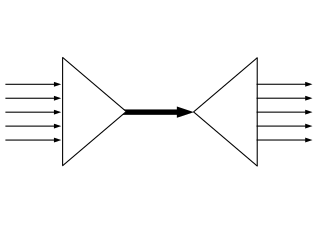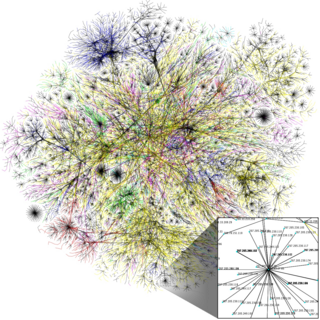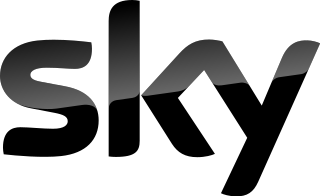Digital subscriber line is a family of technologies that are used to transmit digital data over telephone lines. In telecommunications marketing, the term DSL is widely understood to mean asymmetric digital subscriber line (ADSL), the most commonly installed DSL technology, for Internet access.

Time-division multiplexing (TDM) is a method of transmitting and receiving independent signals over a common signal path by means of synchronized switches at each end of the transmission line so that each signal appears on the line only a fraction of time in an alternating pattern. It is used when the bit rate of the transmission medium exceeds that of the signal to be transmitted. This form of signal multiplexing was developed in telecommunications for telegraphy systems in the late 19th century, but found its most common application in digital telephony in the second half of the 20th century.

A digital subscriber line access multiplexer is a network device, often located in telephone exchanges, that connects multiple customer digital subscriber line (DSL) interfaces to a high-speed digital communications channel using multiplexing techniques.

Internet access is the ability of individuals and organizations to connect to the Internet using computer terminals, computers, and other devices; and to access services such as email and the World Wide Web. Internet access is sold by Internet service providers (ISPs) delivering connectivity at a wide range of data transfer rates via various networking technologies. Many organizations, including a growing number of municipal entities, also provide cost-free wireless access.
A leased line is a private bidirectional or symmetric telecommunications circuit between two or more locations provided according to a commercial contract. It is sometimes also known as a private circuit, and as a data line in the UK.

Telkom SA SOC Limited is a South African wireline and wireless telecommunications provider, operating in more than 38 countries across the African continent. Telkom is a semi-privatised, 39% state-owned enterprise.

Plusnet plc is a British quad play internet service provider (ISP); providing broadband, landline, IPTV and Mobile services. The company was founded in 1997 in Sheffield, South Yorkshire, and became a public limited company (plc) in July 2004 when it was floated on the Alternative Investment Market. On 30 January 2007, Plusnet was acquired by BT Group, but it continues to operate as a separate business. By December 2013, it had over 750,000 customers across the UK.

Digital access carrier system (DACS) is the name used by British Telecom in the United Kingdom for a 0+2 pair gain system.
G.992.5 is an ITU-T standard for asymmetric digital subscriber line (ADSL) broadband Internet access. The standard has a maximum theoretical download speed of 24 Mbit/s. Utilizing G.992.5 Annex M upload speeds of 3.3 Mbit/s can be achieved.
The 21st Century Network (21CN) programme is the data and voice network transformation project, under way since 2004, of the UK telecommunications company BT Group plc. It was intended to move BT's telephone network from the AXE/System X Public Switched Telephone Network (PSTN) to an Internet Protocol (IP) system. As well as switching over the PSTN, BT planned to deliver many additional services over their new data network, such as on-demand interactive TV services.

Be Unlimited was an Internet service provider in the United Kingdom between 2004 and 2014. Initially founded as an independent company by Boris Ivanovic and Dana Tobak in 2005, it was bought by Spanish group Telefónica Europe in 2006 before being sold on to BSkyB in March 2013 in an agreement which saw BSkyB buy the fixed telephone line and broadband business of Telefónica Europe which at the time traded under the O2 and BE brands. The deal saw BSkyB agree to pay £180 million initially, followed by a further £20 million after all customers had been transferred to Sky's existing business. The sale was subject to regulatory approval in April 2013, and was subsequently approved by the Office of Fair Trading on 16 May 2013.
Openreach is a functional division of telecommunications company BT plc, that maintains the telephone cables, ducts, cabinets and exchanges that connect nearly all homes and businesses in the United Kingdom to the national broadband and telephone network.

Sky Broadband is broadband service offered by Sky UK in the United Kingdom. With the introduction of Sky Fibre, Sky Broadband now refers to ADSL broadband products.
BT Wholesale and Ventures is a division of United Kingdom telecommunications company BT Group that provides voice, broadband, data, hosted communication, managed network and IT services to communications providers (CPs) in Great Britain, including BT's other divisions: BT Consumer, BT Business and Public Sector and EE. They also offer services for media companies and broadcasters, and its ventures side offers a range of products and services. It provides the voice services to UK customers via 999, 118 500 and Next Generation Text Service, which helps those who can’t hear or speak on the phone. The division is also leading the BT thinking on the internet of things.
Permanent Internet access was first available in Australia to universities via AARNet in 1989. Pegasus Networks pioneered public use in June 1989. The first commercial dial-up Internet Service Provider (ISP) appeared in capital cities soon after, and by the mid-1990s almost the entire country had a range of choices of dial-up ISPs. Today, Internet access is available through a range of technologies, i.e. hybrid fibre coaxial cable, digital subscriber line (DSL), Integrated Services Digital Network (ISDN) and satellite Internet. The Australian Government, in partnership with the industrial sector, began rolling out a nationwide Fibre to the Premises (FTTP) and improved fixed wireless and satellite access through the National Broadband Network in July 2009. Subsequently, the roll out was down graded to a Multi-Technology Mix on the promise of it being less expensive with earlier completion.
Internet access is widely available in New Zealand. Like Australia, it first became accessible to university students in the country in 1989. As of October 2015, there are 1,926,000 broadband connections and 53,000 dialup connections in New Zealand, of which 1,661,000 are residential and 316,000 are business or government.
From its beginnings in 1995, the Internet in Malaysia has become the main platform for free discussion in Malaysia's otherwise tightly controlled media environment. As of Q1 2017, Malaysia has broadband penetration rates of 103.6% and 81.8%.
In Singapore, there are 11,512,900 broadband Internet subscribers. There are three major Internet service providers in Singapore, namely, Singtel, StarHub, and M1 and other growing providers like Pacific Internet, MyRepublic, Colt and ViewQwest. Over the years, the Singapore Government has been promoting the usage of broadband Internet access, as part of its Intelligent Nation 2015 (iN2015) and Smart Nation initiative.

The United Kingdom has been involved with the Internet since it was created. The telecommunications infrastructure provides Internet access to businesses and home users in various forms, including cable, DSL, and wireless. The Internet country code top-level domain (ccTLD) for the United Kingdom is .uk and is sponsored by Nominet.
BT Superfast Fibre is a broadband service in the United Kingdom provided by BT Consumer, the consumer sales arm of the BT Group. The underlying network is fibre-to-the-cabinet (FTTC), which uses optical fibre for all except the final few hundred metres to the consumer, and delivers claimed download speeds of "up to 76 Mbit/s" and upload speeds of "up to 19 Mbit/s" depending on package selected. The fibre terminates in a new roadside cabinet containing a DSLAM, from where the final connection to the customer uses VDSL2 technology.







